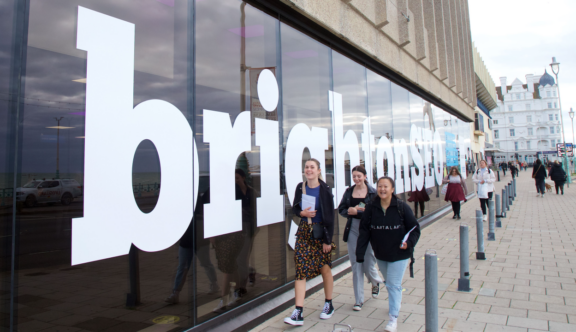The main event’s trusty sidekick delivered outstanding information, advice and guidance. Attended by Dale Olorenshaw, Head of Paid Media & Search, here are his key takeaways from the day.
It’s that time of year again, which means that our offices are a little quieter than usual thanks to some incredible opportunities for our team to stay ahead of the curve and broaden their learning at BrightonSEO. A mainstay in our calendar, this year’s fringe event delivered insightful talks and discussions aimed at equipping marketers with the latest strategies and insights to up their game and deliver a stronger ROI for their clients.
One of the standout talks at the Paid Fringe Event was “Google Ads Efficiencies: Save Money, Improve Performance, Win at Life!” by Fraser Andrews. And win at life, we will!
Fraser delved into the intricacies of Google Ads and shared valuable insights on how to maximise efficiency and get the most out of your advertising budget. His talk emphasised the importance of understanding conversion journeys and optimising touchpoints, making it clear that effective data analysis can be the key to success (or winning at life!). Lots of handy takeaways and guidance for our Paid Media team to instill.
Another enlightening session, helping us to turn water into wine, was “Achieving Big Results With Small Budgets: Case Studies from the World of the Small Spenders” by Vicki Jakes. In a world where small and medium-sized enterprises (SMEs) make up a significant portion of businesses, Vicki shed light on how to achieve remarkable results even with limited resources. Her talk highlighted that SMEs, who had a Median profit in the UK in 2022 of £12,000, were restricted – spending on average between £500 and £5000 each year. Considering small budget campaigns can take three months before hitting a Return On Ad Spend of 300%.
The best way to achieve substantial returns on advertising spend (ROAS) is if they choose the right strategies and platforms, stressing the importance of niche products and well-thought-out campaigns. Leveraging user generated content and retargeting helps many small businesses hit the ROAS sweet spot quicker, but that ultimately, the content needs to resonate with the audience, as with any other campaign to maximise a limited ad spend budget.
Stevy Liakopoulou’s talk on “Optimising Sitemaps for Large Ecommerce Websites” was a deep dive into the intricacies of managing sitemaps for extensive online stores.
The first step is to identify patterns of pages that are not indexed by search engines, allowing you to rectify any issues. Then remove categories with zero products as they may not serve a useful purpose. Googlebot struggles to differentiate between URLs with only numerical differences (e.g., cat1/cat2/product-1 and cat1/cat2/product-2). This applies to both upper and lower case variations. If your website has 50,000 pages or more, consider using subsitemaps to organise and manage your sitemap efficiently.
Google can sometimes treat out-of-stock product pages as soft 404 errors. You can either set them as 301 redirects or remove them from the sitemap. If these pages receive zero web traffic, consider setting them as 401 (unauthorised). Redirect 404 pages if they are worth keeping, and review soft 404 pages to ensure they are appropriately categorised. Always check and remove references to products that have been removed from your website to maintain sitemap accuracy.
For products that are temporarily out of stock, prioritise user experience (UX). Apply an “out of stock” schema, link to other relevant products, encourage users to sign up for notifications when items are back in stock, keep these pages in the sitemap, and eliminate links to these pages until they are available again. For products with multiple variations (e.g., t-shirts with different colours), consolidate them under one product entry in your sitemap. Don’t forget to ensure that your video sitemap is not blocked and includes relevant metadata such as thumbnail URLs.
A final note from our team
Many takeaways have come from this year’s event, more so surrounding benchmarks and ways of working with certain business sizes. From understanding what the average number of touchpoints before a customer converts, to learning the best practices when working with businesses who only have sub £1,000 media spend. We came away with many valuable notes and practices which can be instantly incorporated and taken into consideration.
Dale Olorenshaw, Head of Paid Media & Search
